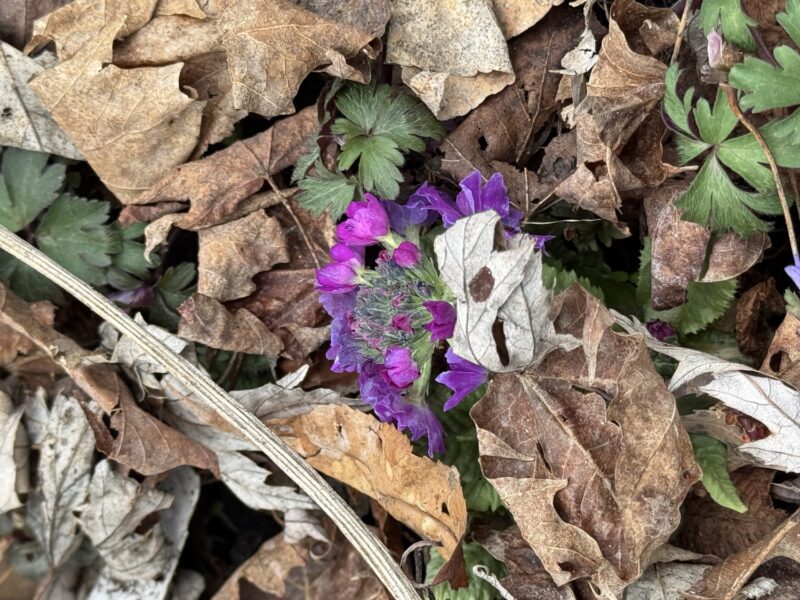

April can be one of the most dangerous and challenging months for gardeners. We can still get a freeze or frost until the last week of the month. In fact, inland areas got a light freeze/frost the middle of last week.
It’s also the month when we begin to see the damage from the coldest winter in a decade and the effects from last fall’s drought. It’s also the month when the warnings go out about the impending appearance of a periodic cicada that will emerge in some areas later in May. And April is the month when the rabbits get so out of hand that you want to eradicate them. Good luck with that.
I have a few plants that begin to emerge from their winter slumber by showing their green tips and some emerging foliage. The crocus will always recover from frosts and freezes as will the daffodils, but I think I may have planted a few varieties of fritillaries a bit too shallow, causing them to emerge a week or more too early. And just to repeat myself, many garden plants are now running a week to 10 days later in blooming or emerging than in a “normal” year.
I have a few things I keep handy for these situations. A thin, white, row cover like Reemay can be used to protect tender or early showing plants. It provides only a few degrees of temperature protection, but it will stop frost from developing on the tender foliage. I cut a small piece with a scissors, enough to cover the plant, leaving an inch or so of overlap on the bottom. The bottom overlap gets pinned into the ground using wire, or I put rocks on it to ensure that the cover won’t blow away.
I also keep a bale of straw mulch in the barn for these situations. I can reach into the cut top of the bale and take out a handful or a pailful of the straw and mound it around and over the susceptible plants. Twigs are used to keep the straw in place, and if enough is used the straw not only provides frost protection but also a bit more insulation than the pieces of row cover.
These cold snaps are usually quick and last for only a day or two on the back side of a cold front that moves through. In most cases I leave the coverings on for two days and then remove them on the third day. The straw can be left behind on the ground around the plant(s) where it acts as a mulch.
Keep your eyes on your lawn. As the soil warms, grubs that have been inactive five to eight inches down begin to migrate up seeking their first spring meals of turf roots. As the soil begins warming more, the feeding increases, and you may begin to see ever-enlarging brown spots in the lawn. At the same time you may also notice crows and other blackbirds pecking in small lawn areas. They sense the presence of the grubs and begin to peck for them as tasty delights. If you dig down you may find white grubs about an inch or less long with two black spots that are their eyes.
In most cases these are the grubs of Japanese or Asiatic beetles, and this is the best time to eradicate them. There’s no reason to treat the whole lawn though, no matter what your lawn service tells you. Treatment is only needed in the affected areas and about a foot beyond that specific area.
Another thing you can do, or not do, in April is not to do too much feeding in your garden beds. Some gardeners like to give garden plants a shot of chemical fertilizers in April as it works in spite of the cold soil whereas organic fertilizers need warmer soil to become available to plant roots. The danger in both cases is in stimulating early, soft growth that is very susceptible to freeze and frost damage in April.
I don’t grow many roses, but the few I have seem to have had a tough winter as well. Little to no snow cover for insulation and plenty of cold wind to desiccate exposed stems. I’m not sure yet if I’ve lost any, but I have seen the telltale red nubs of bud growth on several canes just above the soil line. It’s critically important to know if any of the buds that you see are growth from the grafted canes or if they are emerging from the root stock they are grafted to. If the buds are clearly emerging from below the graft and not from above it the buds and any growth should be removed as all you’ll get are the junk flowers from the root graft, which you don’t want.
As soon as you know you’ve got good growth on these roses you can begin to feed them using an organic fertilizer high in phosphorus, the middle number on the fertilizer packaging. Roses are heavy feeders and should be given an application of an organic rose food every three to four weeks through the end of the summer. You can also begin to spray the stems and buds with a light horticultural oil (organic of course) on a mild day to begin controlling insects and rose diseases. This practice should continue every three to four weeks unless it is excessively rainy, in which case you may shorten the interval to every two to three weeks.
There’s been some media reporting on the return of the periodic cicada on Long Island. This is brood XIV, one of many broods that emerge on Long Island. The fact though is that the East End gets only very mild outbreaks if any. This is due to our sandy soils, which are very inhospitable to the cicada grubs that develop in the ground for a decade or more. They are much more likely to occur from Riverhead to the west though outbreaks on the East End can happen.
There are two types of damage that the cicadas can do, but both are minor. Some damage can be done to the roots of the trees whose soils they live in, but there’s little that can be done about this and the damage is minor. But when the females emerge, mate and lay their eggs they do so on the twigs of trees. As a result the tips of the twigs die out, but again, this is only something to be aware of since it’s not all that common out here and the damage is little more than Mother Nature doing some pruning.
Winter and fall drought damage is also being reported on some evergreens including azaleas and rhododendrons as well as some newly planted junipers. Don’t panic. Wait a while until these plants have flushed out in early to mid-May and then prune out the damaged parts. Do not feed these plants as the fertilizer may further damage the roots but a light liquid feed of an organic fertilizer in mid-May will help but it won’t cure the winter damage.
And the rabbits. They seem to hide under the forsythias and under wood piles and informal “compost” piles where they breed. They just love new lush growth in the gardens and on the lawn, leaving behind their telltale piles of poop pellets. If you’ve got new plantings or emerging plantings, fence them in. Repellents work but only temporarily. A cat or a well-trained Jack Russell can do wonders. Other than that, don’t give them areas where they can hide and nest. Piles of brush are a prime nesting spot.
Just a few words about your lawn. If you or your landscaper has applied a preemergent for weeds in the lawn, seeding patches or small open spots just won’t work. Ah, but there is a trick if you must seed some small spots and your Pre-M hasn’t gone down yet. Before making that application (no, it’s not too late) cover these spots with a sheet of newspaper so the herbicide doesn’t hit those spots. After the Pre-M goes down you can seed. Larger areas? Wait till late August. Keep growing.
 More Posts from Andrew Messinger
More Posts from Andrew Messinger